Saturn's rings aren't just planetary bling—they have a lot to teach us about how solar systems could coalesce from disks of debris orbiting other stars. For the last six years, a school bus–sized spacecraft named Cassini has been exploring the Saturn system, sending back astonishing pictures of the rings and the moons that help shape them. The moons have been grabbing most of the headlines. Titan's methane lakes mimic Earth's water cycle, and its primordial atmosphere could be a stand-in for ours before life began. And Enceladus's icy geysers mark a spot where life might someday be found.
But the rings are much more than just icy rubble. The more closely we look at them, the more complex they appear. In August 2009, the rings were thrown into high relief, literally, during Saturn's vernal equinox. As the sun crossed into the northern hemisphere, its rays shone parallel to the rings for about four days—an alignment that happens once every 15 years or so. And as the rings themselves slipped into shadow, previously unseen features revealed themselves.
Explains JPL's Linda Spilker, Cassini's project scientist, "It's like standing outside right before the sun sets. Your shadow gets very long. Anything that's a little bit bigger, or sticks up, casts a shadow." The shadows betrayed—among other things—curtains of ice particles up to four kilometers tall, created by Daphnis, one of Saturn's moons. Daphnis orbits at a slight tilt with respect to the rings, and when it crosses the ring plane, it drags some of the ring material after itself. Like the rooster tail behind a speedboat at full throttle, this disturbance quickly subsides in Daphnis's wake.
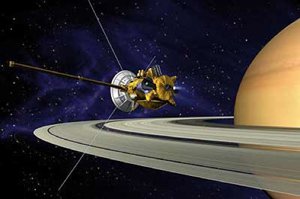
In fact, the rings abound with wakes and waves of all sorts, sculpted by the gravity of passing moons. The equinox gave us a closer look at waves discovered by JPL's Voyager mission, including spiral density waves created by orbital resonances—as when a set of ring particles travels around Saturn exactly twice for every orbit of a moon, for example. The repeated gravitational tugs create compressional waves analogous to the spiral arms of our own Milky Way, says the Space Science Institute's Carolyn Porco (MS '79, PhD '83), head of the Cassini imaging team. "They're much more tightly wound than the spiral structures that you see in galaxies, but they are in fact the same creatures. The physics behind them is the same." If the resonant moon's orbit is slightly askew, three-dimensional bending waves—also spirals—form as well. The density waves and the bending waves propagate in opposite directions, says Spilker, adding a further level of complexity to the rings' structure.
The equinox pictures revealed a new kind of three-dimensional wave, only about 100 meters tall. "From high above, the rippled surface of Saturn's D ring looks like a corrugated roof," says Spilker. "The ripple extends for more than 17,000 kilometers across the ring system. When the Voyagers flew by, it wasn't there." Scientists remain baffled about the ripple's origin, but one possible scenario has a meteoroid slamming into the rings—the pebble in the pond, as it were.
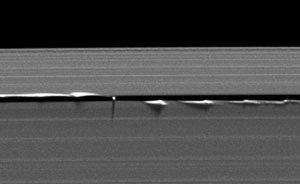
Besides taking pretty pictures in stunning detail, Cassini is analyzing the rings' density and particle-size distribution, revealing an unsuspected clumpiness. These clumps are a kind of spiral density wave, and in the dense B ring the particles actually begin to stick together. The resulting sheets of material grow until they are about 50 meters wide, at which point Saturn's gravity pulls them apart. Under different circumstances, they might have become the seeds of moons.
Cassini is also looking at the rings' composition, which may reveal their age. After the Voyager flybys, we assumed that the rings' bright material meant that they were very young. But various parts of the ring system might have different ages, says Porco. "The massive middle B ring might be a lot older than the A ring. One might be billions of years old and the other only a few tens of millions or hundreds of millions of years." And the rings continue to evolve. Porco's team has discovered small objects in the F ring that disappeared after a couple of orbits, suggesting that the creation and destruction of moonlets continues to this day.
For more on Cassini, see the Engineering and Science Zmag.
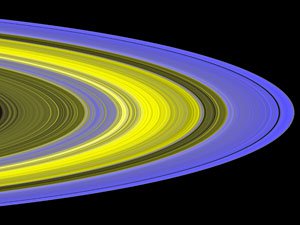 This false-color image from UVIS shows the density and orientation of the clumps. The brightest regions are the densest.
This false-color image from UVIS shows the density and orientation of the clumps. The brightest regions are the densest.
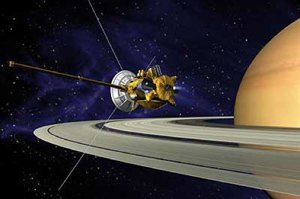 The Cassini orbiter.
The Cassini orbiter.
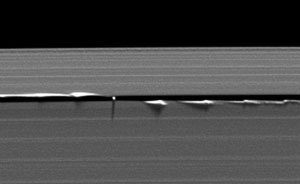 The gravitational pull of a tiny moon named Daphnis, only eight kilometers in diameter, sweeps stray material out of the 42-kilometer-wide Keeler Gap near the outer edge of the A ring.
The gravitational pull of a tiny moon named Daphnis, only eight kilometers in diameter, sweeps stray material out of the 42-kilometer-wide Keeler Gap near the outer edge of the A ring.
